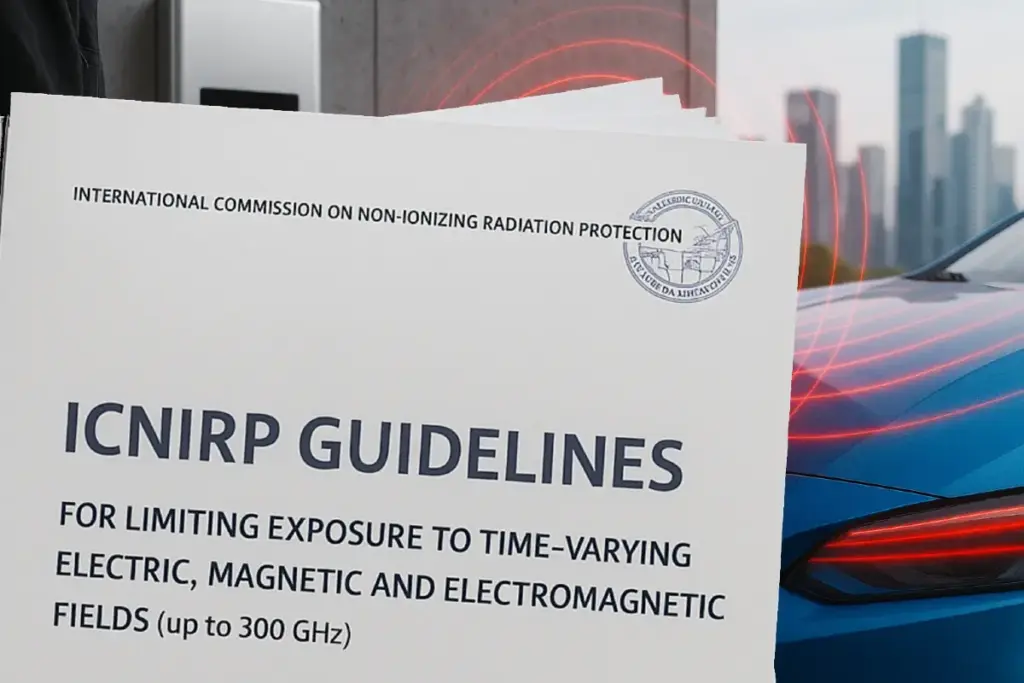What Are ICNIRP Standards and Why Are They Not Adequate to Protect Our Health from EMF in Vehicles?

The International Commission on Non-Ionizing Radiation Protection (ICNIRP) is a globally recognized body that sets guidelines for limiting exposure to electromagnetic fields (EMFs). While these guidelines serve as a reference point for governments and health agencies, their limitations, particularly when applied to the context of electric and hybrid vehicles, have raised significant concerns among scientists and public health experts.
ICNIRP Standards
ICNIRP exposure limits are primarily designed to protect against acute effects of EMF exposure. These are immediate responses in the body, such as tissue heating or nerve stimulation, which occur only at very high levels of EMFs. As such, ICNIRP sets threshold levels that are orders of magnitude higher than the levels typically found in everyday environments, including inside modern vehicles. For extremely low frequency (ELF) magnetic fields, ICNIRP allows exposure up to 100 µT1 for the general public, a level far above what many researchers consider safe for long-term exposure.
These thresholds may be reasonable for short-term, high-level exposures. However, they fail to consider the risks associated with chronic, low-level exposure; the kind experienced daily by drivers and passengers of electric and hybrid vehicles.
Chronic Exposure in Vehicles: A Silent Risk
Electric and hybrid vehicles are significant sources of low-frequency magnetic fields due to high-voltage batteries, inverters, and electrical wiring routed near passengers. Studies show that passengers, particularly those sitting above battery packs or electric motors, may experience prolonged exposure to EMFs well above background levels but still within ICNIRP limits.
However, numerous scientific investigations indicate that even low-intensity magnetic fields (much weaker than the ICNIRP threshold) can cause adverse biological effects when exposure is continuous. These effects include oxidative stress, disruption of melatonin secretion, DNA damage, and changes in brain activity, all of which have been observed at exposure levels below 0.4 µT. Notably, studies such as the pooled analysis by Ahlbom A, Day N, Feychting M, et al. found that children exposed to average magnetic fields above 0.4 µT had nearly double the risk of developing childhood leukemia compared to those with lower exposure. The BioInitiative Report further confirms that increased leukemia risk starts as low as 0.2 to 0.4 µT and argues that current safety guidelines fail to reflect this chronic exposure risk.
Why ICNIRP Guidelines Fall Short
Focus on Short-Term Exposure Only
ICNIRP’s criteria focus on acute health effects and set exposure limits accordingly. While they acknowledge the existence of studies on chronic effects such as leukemia, Alzheimer’s disease, and other neurodegenerative disorders, ICNIRP does not establish explicit reference levels for long-term, low-level exposure. Instead, their limits are based on short-term, immediate biological responses like nerve stimulation and tissue heating, which may leave potential chronic risks unaddressed in regulatory practice.
Lack of Biological Considerations
ICNIRP guidelines are based on physical effects like heating, not biological or cellular effects that can occur without any temperature rise. This overlooks a substantial body of peer-reviewed research indicating subtle but significant biological effects from low-level EMFs.
No Margin of Safety for Vulnerable Populations
ICNIRP does not provide specific protection for pregnant women, children, or individuals with compromised immune systems (groups that may be more sensitive to EMFs).
The Call for Precautionary Standards
Many scientists and institutions (BioInitiative 2012, Section 23: The Precautionary Principle) advocate for precautionary exposure limits, ones that consider the cumulative biological burden of low-level EMFs over time. These proposed limits are typically 10 to 1000 times lower than those recommended by ICNIRP. For example, some suggest adopting a maximum continuous exposure of 0.3–0.4 µT, in line with epidemiological studies linking higher exposures to childhood leukemia.
The BioInitiative Working Group, for instance, calls for biologically based exposure standards that prioritize long-term public health over technological convenience. The precautionary principle, embraced by institutions like the WHO and advanced European countries’ agencies, further supports taking action even in the face of scientific uncertainty when health risks are plausible.
While ICNIRP guidelines serve a foundational part in EMF regulation, they are insufficient to address the unique challenges posed by chronic EMF exposure in electric and hybrid vehicles. Given the accumulating evidence on low-level EMF health risks, there is a pressing need for “precautionary principle” based exposure standards. This would not only better protect public health but also promote responsible innovation in the expanding electric mobility sector.
1at a frequency of 50 Hz

